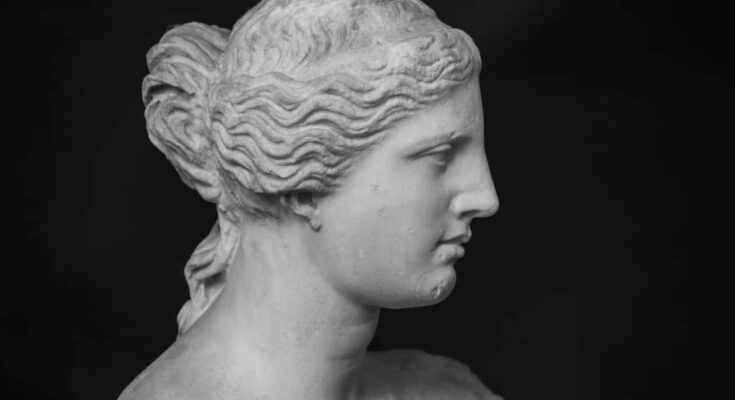
Throughout ancient and modern history, the goddess Aphrodite has remained a prominent figure, a glittering jewel in the landscape of mythology. Known to the Romans as Venus, her image nevertheless transcends cultures.
She embodies the universal concepts of beauty, sexual love, and fertility, emerging not just as a deity but an immortal symbol of desire. For this reason, many statues have been made in her honor throughout the years.
In ancient Greece, Aphrodite was revered as a goddess of fertility, and people often looked to her for blessings. Her worship was most zealous in Cyprus in the cities of Paphos and Amathus, where sacred sanctuaries stood. The sanctuary at Paphos is believed to mark the location where Aphrodite emerged from the sea. From this sacred site in Cyprus, her worship extended to the island of Kythera and later spread to Corinth on the Greek mainland.
This widespread reverence for Aphrodite inspired countless sculptors to capture her beauty in stone and marble, according, of course, to prevalent beauty standards in ancient Greece. At first, statues of Aphrodite displayed her fully clothed and lacking distinctive character. This changed around the fifth century BC, when the greatest Greek sculptors gave her a recognizable identity.
Many of these statues dedicated to the goddess Aphrodite have become timeless icons, recognized worldwide in their original forms or through similar reconstructions.
The Most Famous Statues of Aphrodite, Goddess of Beauty
Aphrodite of Knidos

Aphrodite of Knidos stands as perhaps the most widely known statue dedicated to the goddess. It was carved in the fourth century BC by the Athenian sculptor Praxiteles and marked a novel shift in how the female body was represented in sculptural art.
Prior to this, the depiction of the idealized nude body was reserved for male heroes. Praxiteles broke this tradition by presenting a sensual yet pure image of Aphrodite. In his work, Aphrodite is shown preparing for a ritual bath, her discarded drapery in one hand. With the other, she modestly covers herself, while the graceful, effortless beauty of her upper body is revealed to the beholder.
The statue was originally displayed at the Temple of Aphrodite in Knidos but has not survived to the present day. However, it inspired numerous replicas and variations by both Greek and Roman artists and is a landmark in art history. This is because its artist, Praxiteles, succeeded in capturing the divine female form in a striking blend of grandeur and purity.
Aphrodite of Milos (Venus de Milo)

This statue of Aphrodite undoubtedly stands as one of the most memorable works from the Hellenistic period, and it is the one that has stuck the most in popular culture. Carved in the second century BC with a height of over two meters, it actualizes the goddess in all her stunning beauty.
Aphrodite is portrayed with a bare torso, while drapery covers the lower half of her body. Her eyes and mouth are small and shapely, while her nose and brow are stronger, as per Greek fashion. The statue is named after the island of Milos, the site of its rediscovery in 1820. Today, it stands as one of the crown jewels of the Louvre Museum in France. Notably, the statue is missing both its arms and earlobes.
From a cultural standpoint, Aphrodite of Milos is arguably the most iconic of all Greek statues. It represents the ideal of classical beauty and has become a symbol often referenced in contemporary culture and art. For example, Salvador Dali’s sculpture Venus de Milo with Drawers is its surrealist reimagining. Beyond art, the statue has also appeared in advertisements or as a symbol in movements for cultural heritage and feminism.
Venus Genetrix

The Venus Genetrix is more of a distinct type than a single work of art within the broader tradition of Aphrodite sculptures. The original prototype was believed to have been crafted in bronze in the fifth century BC by the Athenian sculptor Callimachus but has not survived. However, it is said to have depicted the goddess draped in a delicate chiton, gracefully lowered on her left shoulder.
All surviving examples of the Venus Genetrix type are thought to trace their origins back to Callimachus’ lost original. Of these, most were crafted by Roman sculptors and can be found today in collections of the Capitoline Museums, the Louvre, the Hermitage Museum, and the Metropolitan Museum of Art, among others.
Venus de’ Medici

Venus de’ Medici is one of the more recent examples among the most famous statues of Aphrodite. It was created in the first century BC and is thought to be a marble copy of an earlier bronze original from Athens. Crafted in the style of Praxiteles, the statue shows Aphrodite nude and modestly covering herself with her hands. At her feet, dolphins are carved, which suggests she may be captured mid-movement, emerging from the sea.
While the original bronze version is lost, the marble copy carries an inscription that reads “Kleomenes (son) of Apollodoros of Athens made it,” although it is said that it was added by the sculptor to enhance its value. The Venus de’ Medici was quite popular with Romans, leading to numerous reproductions. Today, this marble version is on display at the Uffizi Gallery in Florence, Italy.
Many additional statues of Aphrodite were created during the Roman period, inspired by the Hellenistic tradition. Other notable examples include the Capitoline Venus and the Lely Venus. Today, new fragments or ancient statues of Aphrodite continue to be uncovered. The goddess remains a source of inspiration for contemporary sculptors, who push the boundaries of art with their own interpretations of Aphrodite.



